Search engines have become part and parcel of human life. Though search engines have experienced many changes from past few years. It still relies on keyword based techniques. With the rapid increment of the information on the web, traditional information retrieval based on the keywords is far from user’s satisfaction in recall and precision. In order to improve the accuracy of retrieval in the domain of domesticated plants, an information retrieval model based on the domesticated plants ontology is constructed using protégé. The key purpose of semantic web and ontology is to incorporate heterogeneous data and enable interoperability among distinct systems. Ontologies provide lexical items, allow conceptual normalization and provide different types of relations. The domesticated plants ontology is constructed by gathering and analysing domesticated plants domain information from the web. This ontology is used to create an information retrieval system which facilitates context based search thus replacing the keyword based search. In this paper we have presented the methodology by which the ontology is created and also have shown the experiments that was conducted to prove its performance is better than the traditional keyword based that is being used right now.
Keywords |
| Information Retrieval, Ontology, Semantic Web. |
INTRODUCTION |
| Information retrieval is a process of attaining resources relevant to an information desired from a collection of
information resources. Searches are based on metadata or on full-text indexing.An Information Retrieval process
initiates when a userenters a query into the system. Although search engine technology has evolved a lot in last decade,
the Information Retrieval (IR) system is currently built on mostly keywords. The keyword-based IR uses word form
matching. There are numerous problems associated with this model and therefore most of the time does not meet
user’s needs. The key to solve this problem is to move from keyword matching to semantic matching, understood as
searching by meaning rather than literal strings. (M Fernandez, 2011) |
| Retrieval of information efficiently and accurately has become more and more important.A domain ontology (or
domain-specific ontology) characterisesconcepts which are a part of the world. At present, domain ontology serves as a
backbone of the Semantic Web by providing vocabularies and formal conceptualization of the given domain to
facilitate information sharing and exchange(Guber, 1993). In this study, ontology is used to achieve semantic extension
and provide users with better information services to improve customer needs. |
| In this paper, a model of IR is proposed for domesticated plants based on domain ontology. The experimental data
shows that the precision ratio of the ontology based IR model is higher than the general key word based web
information retrieval model at a certain extent. The structure of the paper is as follows. First, a brief construction
process and implantation on the domesticated plants ontology is given. Second, the IR model is discussed in detail,
which includes the key modules and key functions. Next, the test and evaluation of the model are mentioned and finally
the conclusion is given. |
THE CONSTRUCTION OF THE ONTOLOGY |
Construction method of domain ontology |
| An ontology is defined as a formal, explicit specification of a shared conceptualization.(Guber, 1993) It provides a
common vocabulary to denote the types, properties and interrelationships of concepts in a domain. An ontology may
take a variety of forms, but necessarily it will include a vocabulary of terms, and some specification of their meaning.
This includes definitions and an indication of how concepts are inter-related which collectively impose a structure on
the domain and constrain the possible interpretations of terms. (What is an Ontology?, 2014)Classes are the focus of
most ontologies. Classes define concepts in the domain.(McGuinness, 2000)The following steps are needed for
building domesticated plants ontology. |
Determine the scope and purpose of the domain ontology |
| This stage clarifies the aim, the scope, and the function
which the domain ontology are constructed for. Before the construction, the purpose of the domain ontology should be
clear. The domesticated plants ontology provides certain semantic help to improve the efficiency of information
retrieval for the webpage information. Therefore the semantic relationship of the concept should be provided as much
as possible to improve the information service based on ontology. |
Domain information collection and analysis |
| This stage is a precondition for building domesticated plants ontology.
Only when the information and understanding the domain knowledge were fully collected, it is able to build an
available and correct ontology with sufficient amount of information. The sources information of domesticated
ontology came from Wikipedia, books on domesticated plants, domain experts and other relevantontologies already
existed. |
Define the classes and the class hierarchy |
| Currently there are three class design methods. A top-down development
process which starts with the classification of the most general concepts in the domain and consequent specialization of
the concepts, a bottom-up development process starts with the classification of the most specific classes, and grouping
of these classes into more general concepts and a combination development process is a blend of the top-down and
bottom-up approaches.(McGuinness, 2000) In this paper, a top-down approach was applied to construct domesticated
plants ontology. |
Define the properties of classes |
| The classes alone will not provide enough information to answer the competency
questions. Once we have defined some of the classes, we must describe the internal structure of concepts.(McGuinness,
2000). Initially, it is important to get a comprehensive list of terms between concepts they represent, relations among
the terms, or any property that the concepts may have. These terms contain object properties and data type properties.
All the sub-classes inherit the properties of the classes. |
Create instances |
| The last step is to create individual instances of the class hierarchy. Defining an individual instance
of a class requires 1) choosing a class, 2) creating an individual instance of that class, and 3) filling in the slot values.
(McGuinness, 2000) |
THE BUILDING OF THE DOMESTICATED PLANTS ONTOLOGY |
| The domesticated plants domain ontology describes the concepts and the relationships of the concepts of domesticated
plants. In this model, OWL DL was used to describe the ontology concepts, and achieve the domain ontology with the
tool of Protégé 5.0 Beta. The plant ontology has many categories to compose, for example, the commodities, cooking
plants, ornamental plants, etc., each level comprises of many concept sets (classes, classes’ relations and properties).
The model determines the category, and then defines the class, the property and the relations to correspond to that
category. Finally the classes will be filled with instances. Domain ontology defines the classes and subdivides the
corresponding class information. The domesticated plants ontology describes the property of each class, the
relationship and the expansion relation. |
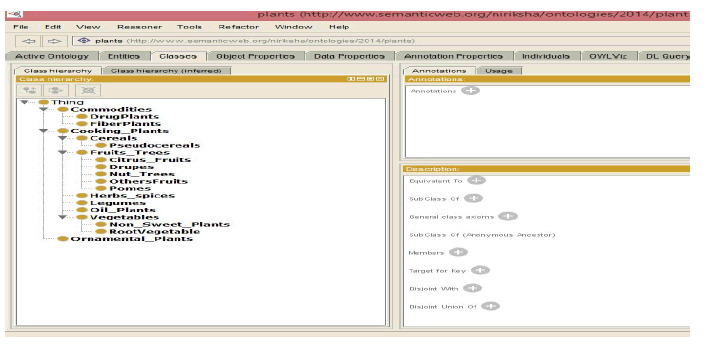 |
CONSTRUCTION OF THE INFORMATION RETRIEVAL MODEL BASED ON DOMAIN
ONTOLOGY |
| Conventional Web consists of human operator and uses computer systems for tasks like finding, searching and
aggregating whereas Semantic Web is the one understood by computers, does the searching, aggregating and
combining information without a human operator. It is easily processable by machines, on a global scale. It is the
efficient way of representing data on the World Wide Web. A semantic retrieval system was constructed based on the
domain ontology, which aims to realise higher efficiency than the keyword-based search engines. This model uses
domain ontology to achieve semantic annotation for the domesticated plants websites, and construct semantic
information retrieval system by the domesticated plants ontology. |
| Any Information Retrieval system is supported by the Retrieval process which involves three basic processes, which
are as follows: |
| i) The representation of the content of the documents, |
| ii) The representation of the user's information need, and |
| iii) The comparison of the two representations. |
| The processes are visualized in Figure 1. |
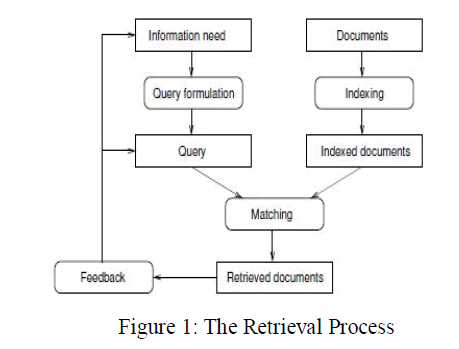 |
| Information Retrieval can be useful for the development, implementation and evaluation of a search engine.
Representing the documents is usually called the indexing process. The process of representing the information need of
a user is often referred to as the query formulation process. The resulting representation is the query. The comparison
of the query against the document representations is called the matching process. Retrieval strategy refers to information retrieval model. Retrieval strategies assign a measure of similarity between a query and a document. Any
Information Retrieval system is based on Information Retrieval process. |
Query and Query Expansion |
| A query consists of a user information need. In its simplest form, a query is composed of keywords and the documents
comprising such keywords are searched for. A query can be simply a word or a more complex combination of
operations involving several words. The most elementary query that can be formulated in a text retrieval system is a
word. The result of word queries is the set of documents containing at least one of the words of the query. |
| A simple way to formulate user queries is using keywords in place of natural languages to match user’s information
needs. In Information Retrieval, the user’s input queries usually are not detailed enough to allow fully satisfactory
results to be returned. Query expansion can solve this problem. |
| Query Expansion is generally aimed to formulate a user query into one that is more responsive for Information
retrieval. Earlier findings have showed that though query expansion had limited retrieval improvement on detailed
queries, it demonstrated great potential for significantly improving results given short queries. Since then there have
been lot of work that is carried on query expansion by the researchers in the IR community. In literature many query
expansion approaches are proposed, and each of them have their own benefits and limitations. |
| The query given by the user is parsed to identify the parts of speech of the words contained in the query. Then the
related synsets for keywords contained in the query are retrieved. The domain keywords that are semantically related to
the query are extracted from the ontology built. This step results in the retrieval of more number of semantically related
words. These domain keywords are then used for the formation of refined queries. These refined queries are queries
with expanded keywords and that has more semantic relevance involved. (Swathi Rajasurya, 2012) |
IMPLEMENTATION OF THE PROTOTYPE SYSTEM AND ANALYSIS OF THE TEST DATA |
ONTOLOGY CONSTRUCTION |
| ONTOLOGY, which is a formal representation of knowledge, is a set of
concepts within a domain and it forms the knowledge base for our project that is constructed based on the concepts
related to the domesticated plants domain. By referring through various plants websites a handful of information is
gathered and based on that,an ontology is constructed taking into consideration, the various important areas under the
domesticated plantsdomain. |
| TOOL USED: Protégé 5.0 Beta |
USER INPUT |
| The user of the system enters a query related to domesticated plants domain in natural
language. The expected output of this query is the semantically relevant web links. The irrelevant links are filtered out. |
PARSING OF INPUT QUERY |
| The input query given by the user is initially parsed by means of the parser.
The parsing is done to analyze the query syntactically which determines the part of speech of each and every word in
the query. In this way the given query is analyzed grammatically. |
| TOOL USED: Stanford Parser |
WORDNET |
| The output obtained from the parser is sent to the wordnet to get the related synsets of various
words contained in the query. So here semantically related words are obtained from the output of the wordnet. |
| TOOL USED: Wordnet API |
EXTRACTION FROM ONTOLOGY |
| This process is of more importance, where the information related to
the given user query is extracted from the built ontology. The initially given query after passing through the Stanford
parser and wordnet, a set of classified and semantically analyzed words are obtained. Thesewords are matched with the
concepts contained in the ontology to get a set of more related key words. At the end of this process we get a collection
of words which are semantically related and domain specific key words. |
| TOOL USED: Jena API |
FORMATION OF REFINED QUERY |
| Next process is the query creation which is done using the
collection of these words. The queries formed will be more refined and will fetch more semantically related web
links,when we pass these queries as input to the search engines. The refined queries are sent to search API which
fetches theweb links related to the user query. |
| TOOL USED: Google Search API |
RESULTS AND DISCUSSION |
| Our experiments reveal the refined query gives more semantically relevant web links and is significantly performing
well than giving query directly to Google Search. We have done these experiments during the month of August and
September 2014. The first 100 links were manually checked for relevance. The sample queries that were processed in
given in the table below. |
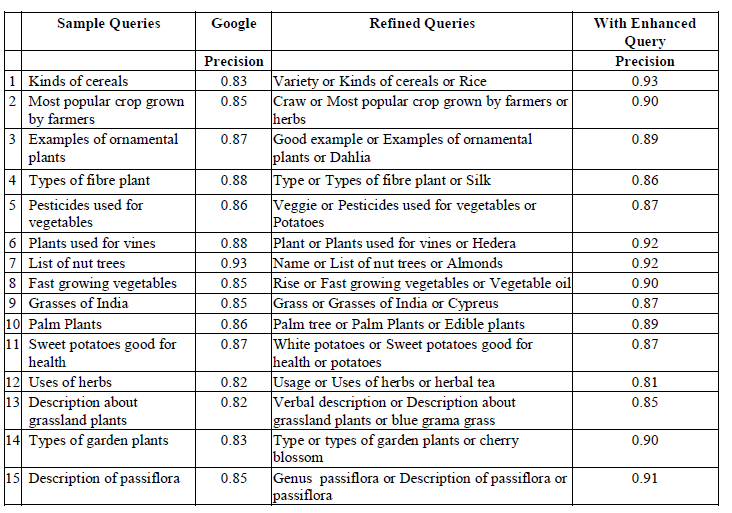 |
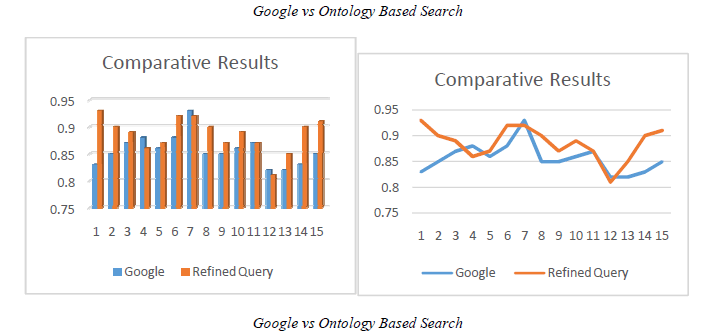 |
| Independent sample t-test is performed using SPSS and the hypothesis can be set as follows:
H0 – there is no significant difference between Google search and ontology search.
H1– there is significant difference between Google search and ontology search.
T-TEST GROUPS=Algorithm ('Google' 'Ontology')
/MISSING=ANALYSIS
/VARIABLES=Precision
/CRITERIA=CI (.95). |
| Table 1 |
 |
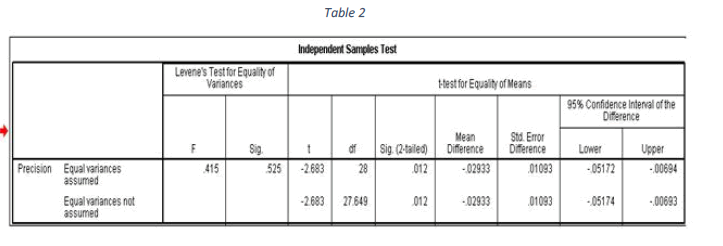 |
| Since Levene’s test significance value = 0.525 which is > 0.05 two groups are having equal variance. The
corresponding p value is 0.012 < 0.05. So, we reject the null hypothesis. |
| It has been concluded that“there is significant difference between Google search and ontology search.” From Table 1, it
is observed that mean for precision using ontology is 0.886 > mean for precision used for Google 0.8567.So, it is
statistically confirmed that precision is improved using the proposed query refinement. |
CONCLUSION |
| In this paper we have presented results of some experiments performed in order to evaluate retrieval efficiency of an
ontology based approach. It is of no doubt that the ontology we have used has increased the accuracy of the search
results. But the accuracy heavily depends on the ontology that is being used for the query refinement process. Though
lot of research is being done to develop a unified global ontology, it is yet to become a reality. |
References |
- Applied ontology - Clinfowiki. (2014, September). Retrieved from Applied ontology - Clinfowiki: http://www.informaticsreview.com/wiki/index.php/Applied_ontology
- Awes Siddiqui, P. A. (2013). ONTOLOGICAL APPROACH FOR IMPROVING SEMANTIC WEB SEARCH RESULTS . IJRET:International Journal of Research in Engineering and Technology , 30-33. Retrieved from http://www.slideshare.net/ijreteditor/ontologicalapproach-for-improving-semantic-web-search-results
- Guber, T. (1993). A translation approach to portable ontology specification. Knowledge Acquisition, 199-220.
- Information retrieval - Wikipedia, the free encyclopedia. (2014, September). Retrieved from Wikipedia, the free encyclopedia: http://en.wikipedia.org/wiki/Information_retrieval
- M Fernandez, I. C. (2011). Semantically enhanced information retieval: An ontology-based approach. Web Semantics: Science, Services and Agents on the World Wide Web, 432-452.
- McGuinness, N. F. (2000). What is an ontology and why we need it. Retrieved from http://protege.stanford.edu/:http://protege.stanford.edu/publications/ontology_development/ontology101-noy-mcguinness.html
- Ming, T. T.-y. (2012). An Ontology-Based Information Retrieval Model for Vegetables E-Commerce. Journal of Interative Agriculture, 800-807.
- Ontology (information science) - Wikipedia, the free encyclopedia. (2014, August). Retrieved from Wikipedia, the free encyclopedia: http://en.wikipedia.org/wiki/Ontology_(information_science)
- Social Research Glossary. (2007). Retrieved from Quality Research International: http://www.qualityresearchinternational.com/socialresearch/ontology.htm
- Swathi Rajasurya, T. M. (2012). SEMANTIC INFORMATION RETRIEVAL USING ONTOLOGY IN UNIVERSITY DOMAIN.
- What is an Ontology? (2014, September 24). Retrieved from School of Computer Science, The University of Manchester: http://www.cs.man.ac.uk/~stevensr/onto/node3.html
|